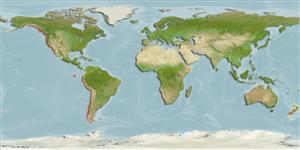Cryptomya californica (Conrad, 1837)
California softshell| Native range | All suitable habitat | Point map | Year 2050 |

|
| This map was computer-generated and has not yet been reviewed. |
| Cryptomya californica AquaMaps Data sources: GBIF OBIS |
تصوير گوگل | No image available for this species;
drawing shows typical species in Myidae.
رده بندی / Names اسامي عام | مترادف | CoL | ITIS | WoRMS
Bivalvia | Myida | Myidae
Environment: milieu / climate zone / تغييرات عمق / distribution range بوم شناسي
; لب شور; تغييرات عمق 0 - 80 m (مرجع 95344). Subtropical
Distribution كشورها | مناطق سازمان خوار و بار جهاني (FAO) | Ecosystems | ظهور | معرفي
Northeast Pacific: Gulf of Alaska, USA, Peru.
Length at first maturity / Size / Weight / سن
بلوغ: Lm ? range ? - ? cm Max length : 2.8 cm SHL جنس نر / بدون خواص جنسي; (مرجع 95344)
Life cycle and mating behavior بلوغ | تولید مثل | تخم ریزی | Eggs | Fecundity | Larvae
مآخذ اصلی
مراجع | هماهنگ كننده | همكاران
Anker, A., G.V. Murina, C. Lira, J.A.V. Caripe, A.R. Palmer and M.S. Jeng 2005 Macrofauna associated with Echiuran burrows: a review with new observations of the innkeeper worm, Ochestostoma erythrogrammon Leuckart and Rüppel, in Venezuela. Zoological Studies 44(2):157-190. (مرجع 1175)
وضعيت در فهرست قرمز IUCN
(مرجع 130435: Version 2025-1)
وضعيت از نظر سايتس (مرجع 108899)
CMS (مرجع 116361)
خطر برای انسان ها
استفاده انسانی
| FishSource |
ابزارها
اطلاعات بيشتر
تركيب غذايي
مصرف غذايي
شکارچیان
Max. ages / sizes
Length-weight rel.
Length-length rel.
نوسانات طولی
Mass conversion
فراواني
منابع اينترنتي
BHL | BOLD Systems | CISTI | DiscoverLife | FAO(Publication : search) | Fishipedia | GenBank (ژنوم, نوکلئوتيد) | GloBI | Gomexsi | Google Books | Google Scholar | Google | PubMed | Tree of Life | Wikipedia (برو, جستجو) | Zoological Record



